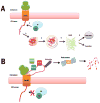Can modulators of apolipoproteinB biogenesis serve as an alternate target for cholesterol-lowering drugs?
- PMID: 29627384
- PMCID: PMC5953829
- DOI: 10.1016/j.bbalip.2018.03.010
Can modulators of apolipoproteinB biogenesis serve as an alternate target for cholesterol-lowering drugs?
Abstract
Understanding the molecular defects underlying cardiovascular disease is necessary for the development of therapeutics. The most common method to lower circulating lipids, which reduces the incidence of cardiovascular disease, is statins, but other drugs are now entering the clinic, some of which have been approved. Nevertheless, patients cannot tolerate some of these therapeutics, the drugs are costly, and/or the treatments are approved for only rare forms of disease. Efforts to find alternative treatments have focused on other factors, such as apolipoproteinB (apoB), which transports cholesterol in the blood stream. The levels of apoB are regulated by endoplasmic reticulum (ER) associated degradation as well as by a post ER degradation pathway in model systems, and we suggest that these events provide novel therapeutic targets. We discuss first how cardiovascular disease arises and how cholesterol is regulated, and then summarize the mechanisms of action of existing treatments for cardiovascular disease. We then review the apoB biosynthetic pathway, focusing on steps that might be amenable to therapeutic interventions.
Keywords: ApolipoproteinB; Autophagy; Cardiovascular disease; Cholesterol; Endoplasmic Reticulum Associated Degradation (ERAD); Very Low Density Lipoprotein (VLDL).
Copyright © 2018 Elsevier B.V. All rights reserved.
Figures



Similar articles
-
The apoB/apoA-I ratio: a strong, new risk factor for cardiovascular disease and a target for lipid-lowering therapy--a review of the evidence.J Intern Med. 2006 May;259(5):493-519. doi: 10.1111/j.1365-2796.2006.01643.x. J Intern Med. 2006. PMID: 16629855 Review.
-
Mipomersen, an apolipoprotein B synthesis inhibitor, reduces atherogenic lipoproteins in patients with severe hypercholesterolemia at high cardiovascular risk: a randomized, double-blind, placebo-controlled trial.J Am Coll Cardiol. 2013 Dec 10;62(23):2178-84. doi: 10.1016/j.jacc.2013.07.081. Epub 2013 Sep 4. J Am Coll Cardiol. 2013. PMID: 24013058 Clinical Trial.
-
New LDL-cholesterol lowering therapies: pharmacology, clinical trials, and relevance to acute coronary syndromes.Clin Ther. 2013 Aug;35(8):1082-98. doi: 10.1016/j.clinthera.2013.06.019. Epub 2013 Aug 8. Clin Ther. 2013. PMID: 23932550 Review.
-
REVIEW: Efficacy and mechanisms of action of statins in the treatment of diabetic dyslipidemia.J Clin Endocrinol Metab. 2006 Feb;91(2):383-92. doi: 10.1210/jc.2005-2084. Epub 2005 Nov 15. J Clin Endocrinol Metab. 2006. PMID: 16291700 Review.
-
Among statin-treated patients, LDL, non-HDL and apoB cholesterol biomarkers were associated with increased risks of cardiovascular events.Evid Based Med. 2013 Apr;18(2):73-4. doi: 10.1136/eb-2012-100787. Epub 2012 Aug 14. Evid Based Med. 2013. PMID: 22893654 No abstract available.
Cited by
-
Apolipoprotein B and Cardiovascular Disease: Biomarker and Potential Therapeutic Target.Metabolites. 2021 Oct 8;11(10):690. doi: 10.3390/metabo11100690. Metabolites. 2021. PMID: 34677405 Free PMC article. Review.
-
Familial Hypercholesterolemia: The Most Frequent Cholesterol Metabolism Disorder Caused Disease.Int J Mol Sci. 2018 Nov 1;19(11):3426. doi: 10.3390/ijms19113426. Int J Mol Sci. 2018. PMID: 30388787 Free PMC article. Review.
-
Protein quality control in the secretory pathway.J Cell Biol. 2019 Oct 7;218(10):3171-3187. doi: 10.1083/jcb.201906047. Epub 2019 Sep 19. J Cell Biol. 2019. PMID: 31537714 Free PMC article. Review.
-
The Targeting of Native Proteins to the Endoplasmic Reticulum-Associated Degradation (ERAD) Pathway: An Expanding Repertoire of Regulated Substrates.Biomolecules. 2021 Aug 11;11(8):1185. doi: 10.3390/biom11081185. Biomolecules. 2021. PMID: 34439852 Free PMC article. Review.
-
Cholesterol Metabolism: A Potential Therapeutic Target in Glioblastoma.Cancers (Basel). 2019 Jan 26;11(2):146. doi: 10.3390/cancers11020146. Cancers (Basel). 2019. PMID: 30691162 Free PMC article. Review.
References
-
- Benjamin EJ, Blaha MJ, Chiuve SE, Cushman M, Das SR, Deo R, de Ferranti SD, Floyd J, Fornage M, Gillespie C, Isasi CR, Jimenez MC, Jordan LC, Judd SE, Lackland D, Lichtman JH, Lisabeth L, Liu S, Longenecker CT, Mackey RH, Matsushita K, Mozaffarian D, Mussolino ME, Nasir K, Neumar RW, Palaniappan L, Pandey DK, Thiagarajan RR, Reeves MJ, Ritchey M, Rodriguez CJ, Roth GA, Rosamond WD, Sasson C, Towfighi A, Tsao CW, Turner MB, Virani SS, Voeks JH, Willey JZ, Wilkins JT, Wu JH, Alger HM, Wong SS, Muntner P. Heart Disease and Stroke Statistics-2017 Update: A Report From the American Heart Association. Circulation. 2017;135:e146–e603. - PMC - PubMed
-
- Ovbiagele B, Goldstein LB, Higashida RT, Howard VJ, Johnston SC, Khavjou OA, Lackland DT, Lichtman JH, Mohl S, Sacco RL, Saver JL, Trogdon JG. Forecasting the future of stroke in the United States: a policy statement from the American Heart Association and American Stroke Association. Stroke. 2013;44:2361–2375. - PubMed
Publication types
MeSH terms
Substances
Grants and funding
LinkOut - more resources
Full Text Sources
Other Literature Sources
Medical
Miscellaneous

